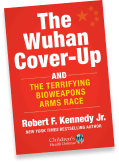‘The Level of Foolishness Here is Unprecedented’: Researchers Pitch ‘One-and-Done’ COVID-Flu Vaccine for Babies
Researchers at the University of California, Riverside, proposed a new RNA-based vaccine they said could provide durable protection for infants against COVID-19 and flu with just one dose. Experts warn the untested technology could lead to breakthrough infections, higher mortality rates and potential brain toxicity in babies.
Miss a day, miss a lot. Subscribe to The Defender's Top News of the Day. It's free.
Researchers are pitching a new vaccine that, according to Forbes, could give infants long-lasting protection from COVID-19 and flu with a single “one-and-done” shot — perhaps even leading to a “universal vaccine.”
The research article, published on April 17 in the Proceedings of the National Academy of Sciences (PNAS) by scientists at the University of California, Riverside (UCR), described how a single dose of a vaccine using “small interfering RNA” (siRNA) molecules demonstrated a “rapid and long-lasting protective immunity” against a lethal virus challenge in immune-deficient mice.
The researchers proposed that an siRNA-based flu vaccine could protect infants without relying on maternal antibodies, according to a UCR press release.
They are considering a nasal spray delivery method instead of the typical intramuscular shot, as “respiratory infections move through the nose, so a spray might be an easier delivery system.”
Experts who spoke with The Defender raised concerns about the lack of human trials and the novel technology’s safety and long-term effects on vulnerable populations.
“The level of foolishness here is unprecedented,” said Brian Hooker, Ph.D., chief scientific officer at Children’s Health Defense. “The immune systems of infants simply cannot tolerate this type of infective agent,” he said. “It will lead to breakthrough infections and higher levels of mortality.”
What is siRNA?
The science of siRNA, which has been in development since the late 1990s, differs significantly from traditional vaccine methods, which typically use inactivated bits of viruses to stimulate the immune system and confer immunity.
It also differs from modified-RNA or mRNA vaccine technology used in the Pfizer and Moderna vaccines, which hijack the body’s cellular machinery and cause it to create the spike protein, purportedly to induce an immune response. Instead, siRNA works by interfering with the natural messenger RNA of replicating viruses, effectively disabling them.
Small interfering RNA or siRNA is a type of RNA molecule that plays a key role in a cellular process called RNA interference (RNAi).
RNAi is a natural mechanism used by cells to regulate gene expression and defend against viral infections. The short, double-stranded siRNA molecules can bind to complementary sequences on messenger RNA (mRNA) and target them for degradation.
By selectively destroying specific natural messenger RNA (mRNA), siRNA can effectively “silence” the expression of corresponding genes. This ability to knock down disease-causing genes makes siRNA a promising tool for developing targeted therapies for conditions such as cancer, viral infections and genetic disorders.
“The siRNA molecules, carried and delivered by nanocarriers, have been explored in the treatments of cancer,” explained Dr. Michelle Perro, an integrative medicine pediatrician and author of “What’s Making Our Children Sick?” “Even in the cancer arena, there are still many hurdles in their employment,” she said.
The siRNA drug patisiran, a treatment for polyneuropathy, uses lipid nanoparticles (LNPs) as the nanocarrier. LNPs have already proven toxic in COVID-19 mRNA vaccines, accumulating in the ovaries, liver, spleen, adrenal glands, bone marrow and other organs.
However, the authors of the PNAS article did not indicate whether their research vaccine contained LNPs. The Defender did not receive a response to our requests for more information by the time this article was published.
Dr. Michael Palmer, a member of Doctors for COVID Ethics, said he was intrigued at the protective effect of siRNA on experimental animals lacking a proper immune system. However, he noted that in immunologically competent animals, “The adaptive immune response snuffs out their crippled vaccine virus before it can generate a proper siRNA response.”
Palmer pointed out that siRNA vaccines might omit the adjuvants commonly used in vaccines, which are responsible for “some of the worst vaccine side effects.”
He said that because the primary goal of siRNA does not include triggering an immune response, “maybe this technology could indeed lead to safer vaccines in the future, at least against some viruses.”
‘The universal vaccine that we have been looking for’
The UCR researchers used a mouse virus transmitted by mosquitoes called Nodamura as a model to test the vaccine on mutant mice lacking T and B lymphocyte immune cells. These immune cells play a crucial role in the body’s adaptive immune response, which is responsible for creating specific antibodies against invading pathogens.
By using mice without these cells, the researchers aimed to demonstrate the effectiveness of the siRNA vaccine against a virus in the absence of traditional adaptive immune responses — responses that are not yet developed in human infants.
“The reason viruses successfully cause disease is because they produce proteins that block a host’s RNAi response,” explained lead author Shou-Wei Ding, Ph.D., distinguished professor of microbiology at UCR. By creating a mutant virus that cannot produce this protein, the researchers were able to weaken the virus and use it as a vaccine to boost the RNAi immune system.
One potential benefit of this approach is that it could eliminate the need for strain-specific vaccines, the researchers said.
“What I want to emphasize about this vaccine strategy is that it is broad,” said UCR virologist and study co-author Rong Hai, Ph.D. “It is broadly applicable to any number of viruses, broadly effective against any variant of a virus, and safe for a broad spectrum of people.”
“This could be the universal vaccine that we have been looking for,” Hai added.
This technology would be effective regardless of viral mutations, according to Hai. “Viruses may mutate in regions not targeted by traditional vaccines,” he said. “However, we are targeting their whole genome with thousands of small RNAs. They cannot escape this.”
The researchers propose the siRNA technology could in the future be applied to other diseases.
“There are several well-known human pathogens; dengue, SARS, COVID. They all have similar viral functions,” said Ding. “This should be applicable to these viruses in an easy transfer of knowledge.”
‘Influenza simply isn’t a baby killer’
Some experts raised concerns about the safety and long-term implications of the siRNA vaccine technology, particularly for infants and immunocompromised individuals.
“There is a reason why vaccine safety trials take decades to release: so that adverse effects/outcomes can be monitored and assessed,” said Perro. “This proposition is not only rushed but not trialed in humans.”
Perro cited the need for a “gold standard double-blinded placebo-controlled study” to guarantee the safety of experimental therapies for vulnerable babies.
Perro raised concerns about the drug’s potential toxicity, particularly when delivered via nasal spray. “The cribriform plate separates the nasal fossa from the cranium and is spongy in nature,” she said. Theoretically, nanoparticles would have direct access to the brain.”
Perro also pointed out that the researchers’ belief that the technology is suitable for babies because their immune systems are still developing is “exactly the same argument that should be presented as to why they should not be allowed into our babies: because their immune systems are still developing and adverse reactions may be fatal.”
Palmer agreed, calling the researchers’ claims that babies will “no longer have to depend on their mothers’ antibodies” a “red light.”
“That’s just the usual warped worldview — that we shouldn’t rely on our inborn and natural ability to defend against disease, but embrace technology instead,” Palmer said. “Influenza simply isn’t a baby killer, so they are proposing an answer to a question that nobody asked.”
Known problems of siRNA technology
The long-term effects of siRNA-based vaccines on the developing immune systems of infants and immunocompromised individuals remain unknown. However, research on siRNA technology has already revealed negative side effects.
One issue is the activation of the innate immune system, which can lead to the production of inflammatory cytokines and the activation of immune cells. This activation can result in inflammation and immune responses against the synthetic RNA molecules.
In severe cases, this immune overreaction, known as a cytokine storm, can be life-threatening.
Another possible concern with siRNA technology is the risk of off-target effects, where the siRNA binds to and degrades unintended mRNAs with similar sequences, leading to unwanted side effects.
These may include dysregulation of gene expression, alterations in cellular processes and potential toxicity.
Commenting on off-target effects, Hooker said siRNAs “by definition are ‘small’ and could have sufficient homology to disrupt the function of genes in the human genome.”
He expressed concern that the new medical paradigm initiated by the “Operation Warp Speed” mentality could “rush this type of technological nightmare to the market and sacrifice many babies.”
Rushing COVID-19 mRNA vaccines to market didn’t go well, according to Perro. “It has now been revealed that the design of the mRNA vaccines via a pseudouridine addition is a carcinogen,” noted Perro, who said scientists have known about its toxicity for decades.
“So we have already unleashed oncogenic [cancer-causing] experimental therapies into our children via the mRNA vaccine and they want to take this further?” she asked.
Perro said Big Pharma has been trying to move away from standard vaccine production due to manufacturing costs.
“By engineering and manipulating RNA and DNA through genetic manipulation using microbes, the process is accelerated,” she said. “They got their foot in the door with the EUA [emergency use authorization] for the COVID mRNA vaccines.”
The regulatory landscape for siRNA therapeutics is still evolving. The U.S. Food and Drug Administration approved patisiran, the first siRNA-based therapeutic, in 2018.
Sign up for free news and updates from Children’s Health Defense. CHD focuses on legal strategies to defend the health of our children and obtain justice for those injured. We can't do it without your support.







No comments:
Post a Comment